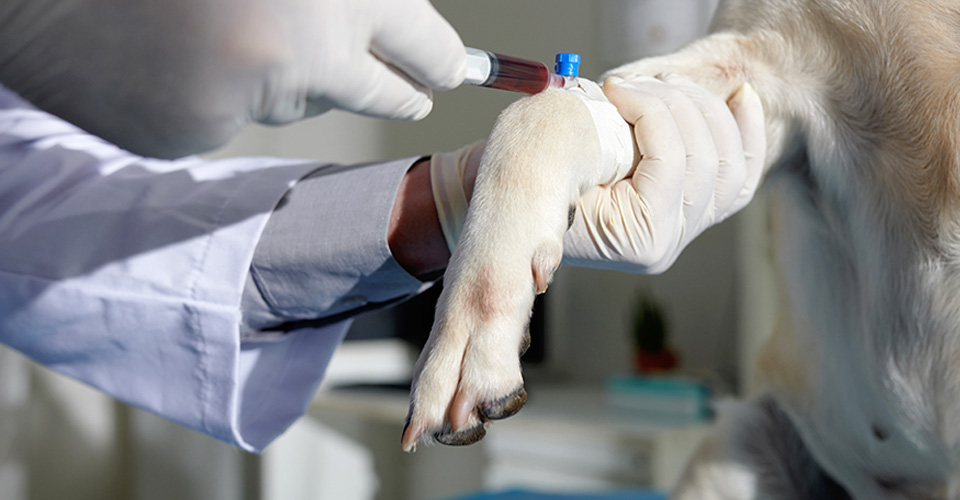Blood donation helps to ensure your dog is healthy.
With each collection, the blood is checked to ensure that is safe for another patient to receive.
In this article, Dr Kenneth Joubert transfuses a few facts to help you draw the right conclusions.
About Dr Kenneth Joubert
He’s a specialist veterinary anaesthetist in private practice (there is only a handful in SA). He spends most of his time in clinical practice doing anaesthesia, looking after patients requiring intensive care and managing patients with chronic pain.
He enjoys running roads and trails, working with his hands, and completing home projects.
He also enjoys teaching and training veterinarians and veterinary nurses to upgrade their skills and improve the care of the pets in their practices.
We asked Dr Joubert a few questions about dog blood donation, and this is what he had to say:
Can all dogs donate blood?
Almost all dogs can donate blood.
“However, the size of the dogs determines the amount of blood that can be drawn. Dogs over 20 – 25 kg can donate about 400 ml of blood while dogs between 15 and 20 kg can only donate 200 ml of blood. Dogs smaller than 15 kg can donate but small collection bags are needed, and these are not easily available, so generally only dogs above 15 to 20 kg are accepted. Your dog needs to be an adult (over a year of age) and less than 8 - 10 years of age, healthy with no chronic diseases and amenable to being handled.”
Do all dogs have the same blood type?
Dog blood groups are described by a system of DEA (Dog Eurythcyte Antigens).
“There are 7 different DEA antigens that have been identified. The most antigenic is the DEA 1 antigen which causes most of the blood transfusion reactions. 60% of dogs have the DEA 1 antigen. However, dog blood typing is not that simple as a dog may express more than one DEA antigen making a myriad of possible combinations.
The DEA 4 antigen is considered the universal donor blood group of the canine world. Ninety-eight per cent of dogs have the DEA 4 antigen present on their RBC. All blood donors are tested for the DEA 1 antigen. The blood typing kits for other antigens are not commercially available. However, dogs do not naturally carry antibodies to other blood types. Cats and humans do. This means that for a first transfusion you can give any canine blood to a dog, and you will not see a blood transfusion reaction. However, on subsequent blood transfusion, you can get a reaction. It is better to type a dog first to avoid giving DEA 1 negative dogs DEA 1 positive blood.
DEA 1 positive dogs can receive DEA 1 positive blood. Cross-matching blood before a transfusion is a final safety step to ensure that no blood transfusion occurs. If your pet has had a blood transfusion it may not be used as a donor due to the development of DEA antibodies and the increased risk of a blood transfusion reaction. Some breeds of dogs expressed additional antigen on their RBC, for example the DAL antigen in dalmatians.”
Is there a need for more dog blood donors?
“There is always a need for blood donors to save other pets’ lives. Becoming involved with a blood donation programme with your local veterinarian will help many other pets. Blood products are used to treat dogs with rat poisoning, biliary fever, blood loss, severe infections, and bleeding tendencies. The blood is often split into packed cells and frozen plasma. The packed cells provide red blood cells and need to be used within 4 to 6 weeks. The frozen plasma provides plasma proteins and clotting factors and needs to be used within the next year.
Blood donors are rewarded through discounts or free products such as food, vaccinations, deworming medication, tick and flea treatments or discounts on veterinary services. These programmes are run to ensure the donor stays healthy. Each blood donor clinic has a different set of rewards for your pet so you would need to ask.”
How do you find the veins, and is the process painful?
The blood is normally collected from the jugular vein in the neck. The pain experienced is similar to a needle pick.
“The whole blood donation process takes about 20 to 30 minutes. It starts with a clinical examination to ensure your pet is healthy. Although the needle is quite large the feeling is not any different to a normal needle. The difficult part is getting your pet to lie still for about 10 minutes while the blood is collected. Many dogs can be bled without any sedation. Some excitable dogs do require sedation, though. After the blood is collected, pressure is applied to the vein for a few minutes to make sure it doesn’t form a haematoma. After that, your pet is ready to go home.”
This blog is intended for informational purposes only and should in no way be regarded as a substitute for professional veterinary advice.



